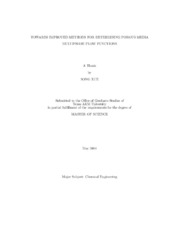| dc.description.abstract | The mathematical modeling and simulation of the flow of fluid through porous
media are important in many areas. Relative permeability and capillary pressure
functions are macroscopic properties that are defined within the mathematic model.
Accurate determinations of these functions are of great importance.
An established inverse methodology provides the most accurate estimates of the
unknown functions from the available data. When the inverse method is used to determine
the flow functions, the media properties, absolute permeability and porosity
are typically represented by single average values for the entire sample. Fortunately,
an advanced core analysis tools utilizing nuclear magnetic resonance (NMR) spectroscopy
and imaging (MRI) to determine complete distributions of porosity and
permeability has been developed. The process for determining multiphase properties
from experimental data is implemented with the computer program SENDRA. This
program is built around a two-dimension, two-phase simulator. In this thesis, the
computer code is extended to represent all three spatial coordinate directions so that
the porosity and permeability distributions in three-dimensional space can be taken
into account. Taking the sample's heterogeneity into account is expected to obtain more accurate multiphase property. Three synthetic experiments are used to show the
erroneous estimation of flow functions associated with the homogeneity assumption.
A proposal approach is used to predict the relative permeability of wetting phase
using NMR relaxation data. Several sets of three-dimensional NMR experiments are
performed. Three-dimensional saturation distribution and relaxation are determined.
Relative permeability of wetting phase are calculated by applying an empirical relation.
This approach provides a in situ measurement of relative permeability of wetting
phase from NMR data. | en |


